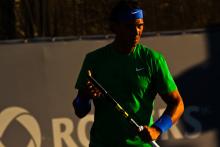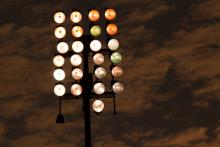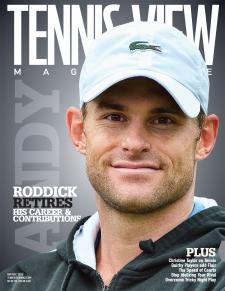Don't miss any stories → Follow Tennis View
FollowTennis at Night Under Lights
If you have an aversion to playing tennis at night under lights, you’re not alone. Many players prefer hitting during natural daylight because they see the ball better. Darkness can complicate the game, but understanding its elements may help you see the game more clearly.
Grim Darkness
 In defense of night tennis, the discipline does offer some advantages: cooler temperatures, less humidity and sweat, consistent shadows, faster cardio recovery time, fewer bugs, no sun glare or need for sunglasses and greater court availability, to name the obvious. Regardless of the benefits, the majority of tennis players find that the evening presents greater obstacles: poor lighting, poor night vision and unfamiliar surroundings lead the list of complaints.
In defense of night tennis, the discipline does offer some advantages: cooler temperatures, less humidity and sweat, consistent shadows, faster cardio recovery time, fewer bugs, no sun glare or need for sunglasses and greater court availability, to name the obvious. Regardless of the benefits, the majority of tennis players find that the evening presents greater obstacles: poor lighting, poor night vision and unfamiliar surroundings lead the list of complaints.
First, to improve night tennis, teaching professionals say you must play more at night. The simple task of practicing against a dark canvass under lights will increase familiarity with the elements. “It’s very common to have reduced visibility playing under lights and especially challenging when the ball is hit high where you lose sight of it in the darkness,” says Cesar Villarroel, Mission Inn Resort & Club director of Tennis & Fitness, Howey-in-the-Hills, Florida. Concentration, he adds, is key to evening play. “I instruct my students to focus on the seams of the ball and to watch the rotation. It also enables a player to recognize whether the ball is approaching with top spin, under spin or no spin at all.”
The quality of light is an aspect that may hinder night vision. Fernando Velasco, director of Tennis at Circle C Tennis Club, Austin, Texas, says even though there are standards of how many foot-candles should be on a tennis court, it varies from public to private to championship courts. Also the number of light bulbs and poles vary from club to club, leaving players in a constant state of adjustment.
Few clubs or parks provide high quality lights, and those that do may not replace them frequently enough due to inexperience or to save money, informs Master Professional Ken DeHart, San Jose SRC director of tennis. “Few facilities use a light meter to gauge emissions flow onto the courts that would detect dark spots,” DeHart says. “Another factor is the height of the light posts and if there are individual light sets for each court or if the lights are placed high enough to cover three courts with only lights located on the outside of the first and third court,” he adds.
If the quality of the lights are adequate and the number of lights per court are correct, DeHart says wearing optic yellow lenses could help players see the ball better at night. He suggests visiting a sports eye doctor for an examination.
Optimize Visual Focus
 The ability to see well after sunset grows increasingly more challenging as we get older, says Charly Rasheed, tennis director at Wild Dunes Resort, South Carolina. Fortunately, there are recommendations that a player can exercise to optimize visual focus under the lights. “The most seamless way to adapt to night time play is to start while there are remnants of daylight,” Rasheed says. “If a player knows in advance that they’re going to play at night, it’s beneficial to arrive early and warm up while there is still daylight,” adding that eyes naturally adapt well to the transition from daylight to nighttime.
The ability to see well after sunset grows increasingly more challenging as we get older, says Charly Rasheed, tennis director at Wild Dunes Resort, South Carolina. Fortunately, there are recommendations that a player can exercise to optimize visual focus under the lights. “The most seamless way to adapt to night time play is to start while there are remnants of daylight,” Rasheed says. “If a player knows in advance that they’re going to play at night, it’s beneficial to arrive early and warm up while there is still daylight,” adding that eyes naturally adapt well to the transition from daylight to nighttime.
If a player cannot arrive early to a match, however, and it’s already dark outside, a proper warm up is essential. Rasheed suggests dissecting the warm up into segments.
- It is important to apply a series of progressions to the warm up. Before striking the first ball, the player should jump rope or engage in a movement drill that coordinates hands, feet, core and eyes.
- Once on court, the player should start hitting from close proximity from his partner or opponent, otherwise known as “short” or “mini” tennis. A soft volley rally where emphasis is placed on the continuous movement of the feet is optimal.
- The next progression is to drop back to the service line and hit a light groundstroke rally, evolving until both players are hitting from the baseline. The performance goals should be to find a rhythm with 50 percent of the swing speed potential and 100 percent of the player’s movement potential. As the player begins acquiring a rhythm through movement the swing speed can increase incrementally.
In conclusion, whether playing competitively or social, inevitably, there will come a time when playing a night match is necessary. Understanding the inherent challenges of evening play and how to best adjust will improve your skill dramatically. So rather than turning a cheek to playing under lights, change your perception and learn to adapt to darkness.
5 Tips for Night Play
- Do not wear sun glasses.
- Do not wear bi-focal glasses – the path of the ball will look different from seeing it above the line and below the line.
- Adjust the service toss so the ball will not be in the same path as the light bulb.
- On the overhead, let the ball bounce before hitting.
- On ground strokes or return of serves, follow the path of the ball from the moment of impact upon the racquet.
-Fernando Velasco
This article is from the Nov / Dec 2012 issue |
|

|
SOLD OUT Subscribe now and you'll never miss an issue!
|










